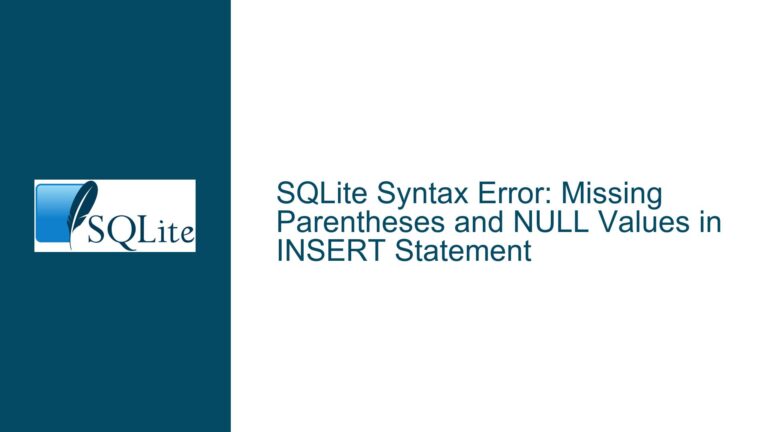Unexpected Data Persistence and Insertion Issues in SQLite Table
Understanding Mismatched Data and Insertion Behavior in sys.abcattbl
1. Infinite Loop in Data Insertion Logic and Transaction Integrity
The code provided contains an infinite loop structure (for(;;)) that iterates over the results of a SELECT query fetching table/view names. This loop lacks termination logic for when all rows have been processed. SQLite’s sqlite3_step() function returns SQLITE_ROW for each row in the result set and SQLITE_DONE when no more rows are available. Without checking for SQLITE_DONE, the loop runs indefinitely, requiring external termination (e.g., killing the process). This abrupt termination disrupts SQLite’s transaction lifecycle. By default, SQLite operates in auto-commit mode, where each INSERT is its own transaction. However, if the process is terminated before the loop ends, any pending INSERT operations not yet auto-committed will be rolled back. This creates inconsistencies: some rows may persist, while others are lost. The observed "first record" effect suggests partial commits before termination.
Key Analysis:
- The infinite loop prevents proper transaction finalization.
- External termination forces incomplete operations, leaving the database in an inconsistent state.
- Auto-commit behavior depends on the timing of termination: rows inserted before interruption persist; those in progress do not.
2. Primary Key Conflicts and INSERT OR IGNORE Semantics
The sys.abcattbl table has a composite primary key on abt_tnam and abt_ownr. The INSERT OR IGNORE statement attempts to insert rows with abt_ownr set to an empty string (''). If a row with the same abt_tnam and abt_ownr already exists, the IGNORE clause skips the insertion. The sample output shows a row with abt_tnam='leagues' and abt_ownr='', which likely predates the current code execution. The abt_cmnt field contains 'Leagues table', a value not present in the provided INSERT statement (which uses '' for abt_cmnt). This confirms that the observed row was inserted by a prior operation, and the current code’s INSERT OR IGNORE silently skips updating it due to primary key conflicts.
Key Analysis:
INSERT OR IGNOREdoes not update existing rows; it only avoids insertion errors.- Legacy data from previous runs or external processes remains intact, leading to mismatched values.
- The primary key definition determines uniqueness: any pre-existing rows matching
abt_tnamandabt_ownrwill block new inserts.
3. Schema-to-Data Type Mismatches and Silent Conversions
SQLite employs dynamic typing, but schema-defined column types influence affinity rules. The sys.abcattbl schema declares specific types (e.g., char(1), smallint), which guide SQLite in converting inserted values. The INSERT statement provides string literals ('N') for char(1) columns (e.g., abd_fitl), but the sample output shows 0 instead of 'N' in some fields. This suggests either:
- Prior Data Corruption: Existing rows were inserted with integer values (
0) instead of strings ('N'). - Binding Errors: The code binds incorrect values (e.g., integers instead of strings) to parameters.
- Silent Type Conversion: SQLite coerces values to match the column’s affinity. For example, inserting
'N'into a column withsmallintaffinity converts it to0because'N'cannot be parsed as an integer.
Key Analysis:
- Schema-defined affinities override declared types during value conversion.
- Mismatched data types between
INSERTvalues and schema expectations lead to silent coercion. - Legacy rows with incorrect data types will persist unless explicitly updated or deleted.
Resolving Infinite Loops, Primary Key Conflicts, and Type Mismatches
Step 1: Terminate the Loop Correctly and Ensure Transaction Finalization
Modify the loop to exit when sqlite3_step() returns SQLITE_DONE:
while (true) {
res = sqlite3_step(stmt);
if (res == SQLITE_ROW) {
// Process row
} else if (res == SQLITE_DONE) {
break; // Exit loop
} else {
// Handle error
break;
}
}
After processing all rows, finalize the statements and commit explicitly if using transactions:
sqlite3_finalize(stmt);
sqlite3_finalize(stmt1);
// If transactions are used:
sqlite3_exec(m_db, "COMMIT;", nullptr, nullptr, nullptr);
Why This Works:
- Prevents infinite loops by respecting SQLite’s result codes.
- Ensures all pending operations are committed gracefully.
Step 2: Audit Existing Data and Adjust Primary Key Strategy
Identify Conflicting Rows:
SELECT abt_tnam, abt_ownr FROM "sys.abcattbl";Compare results with the tables returned by
SELECT name FROM sqlite_master. Rows with existingabt_tnamvalues will block new inserts.Delete Legacy Data (if appropriate):
DELETE FROM "sys.abcattbl" WHERE abt_ownr = '';Revise Primary Key or Insert Logic:
- Use
INSERT OR REPLACEinstead ofINSERT OR IGNOREto overwrite existing rows. - Modify the primary key to include more columns if uniqueness requirements have changed.
- Use
Why This Works:
- Removes obsolete data that causes
IGNOREbehavior. REPLACEensures new data overwrites old entries.
Step 3: Enforce Strict Data Type Alignment in Inserts
Explicitly Cast Bound Values:
Ensure values bound tochar(1)columns are strings ('N'/'Y'), not integers. For example:// Incorrect: Binding integer 0 for a char(1) column sqlite3_bind_text(stmt1, 4, "0", -1, SQLITE_STATIC); // Correct: Binding string 'N' sqlite3_bind_text(stmt1, 4, "N", -1, SQLITE_STATIC);Validate Schema Affinities:
UsePRAGMA table_info("sys.abcattbl");to inspect column affinities. Ensure inserted values match these affinities. Forsmallintcolumns, bind integers; forcharcolumns, bind strings.Rebuild the Table with STRICT Mode (SQLite 3.37+):
CREATE TABLE "sys.abcattbl"(...) STRICT;This enforces type checking and rejects invalid data.
Why This Works:
- Aligns inserted data with schema expectations.
- Strict mode prevents silent type conversions.
Final Validation Steps
Test Insertion in Isolation:
Run the program after deleting all rows fromsys.abcattbl. Verify that inserted rows match the expected values.Enable SQLite Trace Logging:
Usesqlite3_trace_v2()to log all SQL operations. Confirm thatINSERTstatements are executed with correct parameters.Check Encoding Conversions:
The code usesm_myconv.to_bytes(query2.c_str())to convert a wide string to UTF-8. Validate that this conversion handles non-ASCII characters correctly, especially if table names contain Unicode.
By addressing infinite loops, primary key conflicts, and type mismatches systematically, the anomalies in sys.abcattbl can be resolved, ensuring data integrity and alignment with application expectations.






